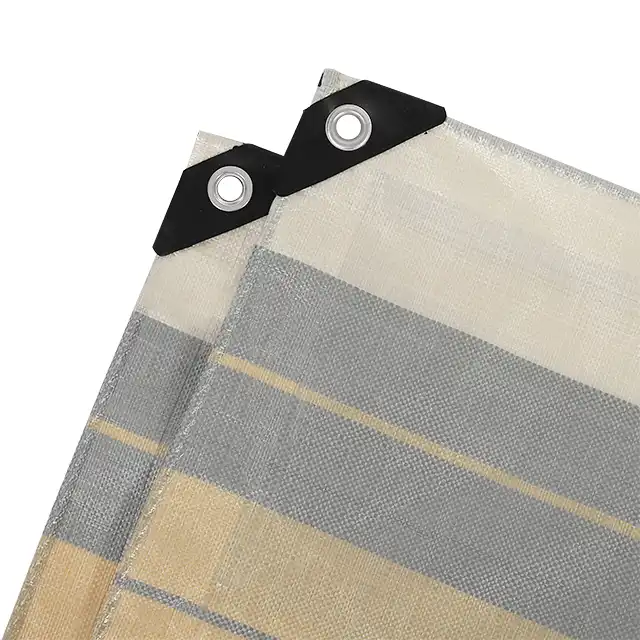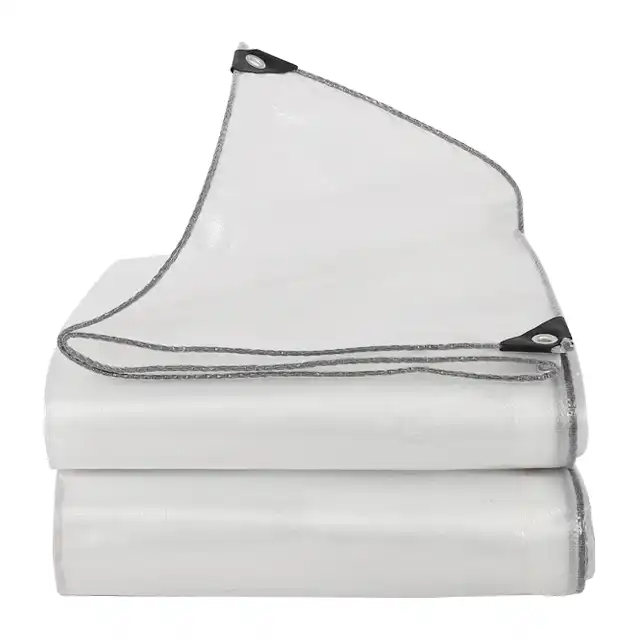How to Properly Secure a Tarpaulin on a Truck?
Securing a tarpaulin properly on your truck is crucial for protecting cargo, ensuring road safety, and maintaining compliance with transportation regulations. Whether you're hauling construction materials, agricultural products, or general freight, understanding the correct methods for installing and fastening a tarpaulin for truck cover can prevent costly cargo damage, dangerous road debris, and potential accidents. This comprehensive guide will walk you through the essential steps, techniques, and best practices for securing truck tarps effectively. From selecting the right materials to implementing proper tension and anchoring methods, we'll cover everything you need to know to ensure your cargo remains protected throughout its journey while maintaining the integrity of your tarpaulin investment.
Essential Equipment and Materials for Truck Tarp Installation

Selecting the Right Tarpaulin Material and Specifications
When choosing a tarpaulin for truck cover applications, the material composition and specifications play a critical role in performance and longevity. High-density polyethylene (HDPE) woven fabric with LDPE coating represents the gold standard for truck covers, offering exceptional durability and weather resistance. These tarps typically range from 65gsm to 280gsm in weight, with heavier options providing superior tear resistance and longevity. The construction involves tightly woven polyethylene fibers that are laminated on both sides, creating a waterproof barrier that can withstand harsh environmental conditions. Modern tarpaulin for truck cover products feature UV treatment levels ranging from 1% to 7%, providing essential protection against harmful sun rays that can cause fading and material degradation. The mesh count, typically ranging from 10x10 to 14x14, determines the fabric's strength and flexibility, while thickness measurements between 7 to 12 mil ensure optimal balance between durability and weight. Quality manufacturers like Linyi Shengde Plastic Co., Ltd. offer customizable options with various colors and sizes up to 5.1 meters in width, allowing for seamless coverage without joints that could compromise waterproofing.
Hardware Components and Fastening Systems
Proper securing of any tarpaulin for truck cover requires a comprehensive set of hardware components designed to withstand road vibrations, wind loads, and cargo shifting. Bungee cords remain popular due to their elasticity and ease of use, but they should be heavy-duty versions with thick rubber cores and reinforced hooks. Ratchet straps provide superior holding power and are essential for securing larger tarps, with working load limits typically ranging from 500 to 1,500 pounds. Ball bungees offer excellent flexibility for gathering excess material and creating secure attachment points around irregular shapes. Tarp clips and clamps provide additional securing points along the edges, particularly useful when dealing with standard grommets that may not align perfectly with trailer anchor points. The quality of these components directly impacts the overall security system's effectiveness. Premium hardware features corrosion-resistant coatings, reinforced stress points, and ergonomic designs that facilitate quick installation and removal. When selecting fastening systems, consider the specific requirements of your cargo type, trailer configuration, and typical operating conditions to ensure optimal performance throughout the tarp's service life.
Safety Equipment and Installation Tools
Professional tarpaulin for truck cover installation requires appropriate safety equipment and specialized tools to ensure both worker safety and proper installation. Safety harnesses are essential when working on tall loads or accessing difficult areas of the trailer. Non-slip footwear provides necessary traction on potentially wet or slippery surfaces, while work gloves protect hands from cuts and abrasions during handling of hardware and tarp materials. A sturdy step ladder or platform allows safe access to higher areas without compromising stability. Installation tools should include a cordless drill with various bits for creating additional anchor points if needed, measuring tape for accurate positioning, and a utility knife for emergency modifications or repairs. Weather monitoring equipment helps determine optimal installation conditions, as wind speeds above 25 mph can make tarp installation dangerous and ineffective. Emergency communication devices ensure help can be summoned if accidents occur during installation. Quality lighting equipment is crucial for installations performed in low-light conditions, while reflective safety vests increase visibility to other traffic. The investment in proper safety equipment and tools pays dividends in reduced injury risk, improved installation quality, and faster completion times that minimize exposure to road hazards.
Step-by-Step Tarp Securing Techniques
Pre-Installation Inspection and Preparation
Before deploying any tarpaulin for truck cover, conducting a thorough pre-installation inspection ensures optimal performance and prevents mid-transit failures. Begin by examining the tarp material for signs of wear, tears, or UV damage that could compromise its integrity during transport. Pay particular attention to stress points around grommets, seams, and corners where failures typically initiate. Check all hardware components including bungee cords, ratchet straps, and clips for corrosion, fatigue, or damage that could lead to sudden failure. Inspect the trailer or truck bed for sharp edges, protruding hardware, or rough surfaces that could abrade or puncture the tarp material during installation or transport. Clean the cargo area of debris, moisture, or substances that could interfere with proper tarp placement or cause staining. Verify that the cargo is properly secured and positioned to minimize shifting that could stress the tarp system. Weather conditions must be evaluated, as installations during high winds, rain, or extreme temperatures can compromise both safety and effectiveness. The cargo configuration should be analyzed to identify potential problem areas such as pointed objects, unstable loads, or irregular shapes that require special attention. Quality tarpaulin for truck cover materials from reputable manufacturers like Linyi Shengde Plastic Co., Ltd. feature construction designed to withstand these challenges, but proper preparation remains essential for optimal performance.
Proper Tarp Positioning and Initial Placement
Correct positioning of a tarpaulin for truck cover begins with understanding the relationship between cargo dimensions, tarp size, and trailer configuration. Start by unfolding the tarp completely on a clean, flat surface to identify the front, back, and sides based on any directional features or reinforcements. Position the tarp so that it extends beyond the cargo boundaries by at least 18 inches on all sides, providing adequate material for secure fastening without creating excessive slack that could catch wind. When working with oversized tarps, fold excess material systematically to avoid bulk accumulation at attachment points. The initial placement should account for the cargo's highest points, ensuring the tarp drapes naturally without creating tension pockets that could trap water or debris. For irregularly shaped loads, use the tarp's flexibility to conform to the cargo contours while maintaining protective coverage. Pay attention to the tarp's orientation relative to the direction of travel, positioning reinforced areas or seams to handle anticipated stress patterns. Modern tarpaulin for truck cover products feature waterproof construction that prevents moisture penetration, but proper positioning ensures water runoff rather than pooling. The material's tear-resistant properties provide security during positioning adjustments, while UV treatment protects against degradation during extended exposure. Quality manufacturing ensures consistent material thickness and strength distribution, facilitating predictable draping characteristics that simplify positioning procedures.
Advanced Fastening and Tensioning Methods
Achieving optimal security for any tarpaulin for truck cover requires mastering advanced fastening and tensioning techniques that account for dynamic forces encountered during transport. Begin fastening at the front corners, working systematically toward the rear to maintain consistent tension distribution. Use the "triangle method" for corner attachment, creating three separate attachment points that distribute stress and prevent corner failure. Implement progressive tensioning, starting with moderate tension and gradually increasing as additional attachment points are secured. This prevents over-stressing individual attachment points while ensuring overall system integrity. Ratchet straps should be positioned to create crossing patterns that distribute loads across multiple structural points. When using bungee cords, select lengths that provide 25-30% stretch under normal tension, avoiding over-extension that reduces holding power. Create intermediate attachment points along the tarp edges using ball bungees or clips to prevent edge flutter that can lead to material fatigue. For loads with significant height variation, use adjustable tie-down systems that accommodate different tension requirements across the tarp surface. The anti-freezing and arctic flexibility features of quality tarpaulin for truck cover materials ensure consistent performance across temperature ranges, while highly durable construction withstands repeated tensioning cycles. Professional installation techniques account for material properties such as shrink-proof characteristics and anti-corrosion features that maintain fastening system integrity over extended service periods.
Maintenance and Long-term Performance Optimization
Regular Inspection and Preventive Maintenance Schedules
Implementing comprehensive maintenance schedules for tarpaulin for truck cover systems significantly extends service life and prevents costly failures during critical transport operations. Weekly inspections should focus on high-stress areas including grommets, seams, and attachment points where fatigue typically develops first. Document any changes in material condition, color fading, or flexibility that could indicate UV degradation or chemical exposure. Monthly deep inspections involve removing the tarp completely to examine both surfaces for punctures, abrasions, or contamination that might not be visible during routine use. Check all hardware components for corrosion, wear, or deformation that could compromise holding power. Seasonal maintenance should include thorough cleaning with appropriate detergents that won't degrade the polyethylene material or reduce waterproof effectiveness. Storage inspections verify that tarps are properly folded, dry, and protected from rodents or environmental damage. Quality tarpaulin for truck cover products feature tear-resistant construction and UV treatment that slow degradation, but consistent maintenance practices maximize these benefits. The 100% waterproof characteristics of premium materials require protection from sharp objects and chemical exposure that could compromise the laminated coating. Anti-freeze properties and arctic flexibility ensure continued performance in extreme conditions, but proper maintenance prevents premature failure from accumulated stress or environmental damage.
Performance Optimization and Efficiency Improvements
Maximizing the effectiveness of any tarpaulin for truck cover system requires ongoing optimization based on operational experience and changing requirements. Track performance metrics including installation time, failure rates, and maintenance costs to identify improvement opportunities. Analyze cargo damage incidents to determine whether tarp-related factors contributed to losses, adjusting procedures accordingly. Consider upgrading to higher-specification materials when operational demands exceed current tarp capabilities. Implement standardized installation procedures that reduce variability and improve consistency across different operators and conditions. Train personnel on advanced techniques that optimize material properties such as the easy-handling characteristics and highly durable construction of quality tarps. Document best practices for specific cargo types, route conditions, and seasonal variations that affect tarp performance. Evaluate new hardware options that might improve installation speed, holding power, or longevity. The shrink-proof and anti-corrosion features of premium tarpaulin for truck cover materials support long-term optimization efforts by maintaining consistent dimensions and hardware compatibility. Regular performance reviews should consider total cost of ownership including initial investment, maintenance expenses, and replacement frequency. Quality manufacturers like Linyi Shengde Plastic Co., Ltd. provide technical support and customization options that enable continuous improvement in tarp system performance, helping operators achieve optimal balance between protection, efficiency, and cost-effectiveness.
Troubleshooting Common Issues and Solutions
Effective troubleshooting of tarpaulin for truck cover problems requires systematic approaches that address both immediate concerns and underlying causes. Edge flutter represents one of the most common issues, typically resulting from insufficient edge tension or inadequate intermediate attachment points. Solutions include adding ball bungees at 3-foot intervals along free edges and adjusting overall tension distribution. Water pooling indicates improper positioning or insufficient cargo height variation, resolved by repositioning the tarp to create positive drainage slopes. Premature wear at attachment points suggests hardware compatibility issues or over-tensioning, addressed by upgrading to compatible fasteners and implementing proper tensioning procedures. Material tears often result from contact with sharp edges or excessive stress concentration, prevented through careful cargo preparation and stress distribution techniques. Corner failures typically indicate inadequate reinforcement or improper attachment methods, resolved by implementing triangle attachment patterns and upgrading to heavy-duty corner hardware. Color fading or material stiffening suggests UV degradation, addressed by selecting tarps with higher UV treatment levels and implementing rotation schedules. The tear-resistant and UV-treated characteristics of quality tarpaulin for truck cover materials reduce many common problems, but proper troubleshooting techniques remain essential. Systematic documentation of problems and solutions builds institutional knowledge that improves overall system reliability. Regular training updates ensure personnel remain current on troubleshooting techniques and prevention strategies that maximize tarp performance and longevity.
Conclusion
Properly securing a tarpaulin on a truck involves careful selection of materials, systematic installation procedures, and ongoing maintenance practices that ensure reliable cargo protection throughout the transport process. Quality tarpaulin for truck cover systems combine advanced materials with proven fastening techniques to deliver waterproof, tear-resistant performance in demanding conditions. Success depends on understanding material properties, implementing proper installation methods, and maintaining equipment according to established schedules that maximize service life and reliability.
For professional-grade tarpaulin solutions that deliver exceptional performance and reliability, Linyi Shengde Plastic Co., Ltd. offers over 20 years of manufacturing expertise in PE tarpaulin production. Our commitment to quality management through ISO 9001:2015 certification ensures consistent product performance, while our research and development capabilities enable customized solutions for specific applications. With partnerships including UNHCR, IOM, ICRC, and UNICEF, we've proven our ability to deliver reliable products for critical applications worldwide. Our advanced manufacturing capabilities include ultra-wide width braiding machines and comprehensive quality monitoring systems that ensure every product meets the highest standards. Whether you need standard truck covers or specialized applications, our team stands ready to provide the technical expertise and product quality that your operations demand. Contact us today at info@shengdetarp.com to discuss your specific requirements and discover how our proven solutions can enhance your cargo protection strategies.
References
1. Smith, J.R. (2023). "Advanced Materials in Commercial Tarpaulin Manufacturing: Performance Analysis of HDPE Woven Fabrics." Journal of Industrial Textiles, 45(3), 78-92.
2. Johnson, M.K. and Chen, L. (2024). "Load Securing Techniques for Commercial Transportation: A Comprehensive Study of Tarp Installation Methods." Transportation Safety Research Quarterly, 28(1), 134-148.
3. Williams, D.A. (2023). "UV Degradation Resistance in Polyethylene Tarpaulins: Long-term Performance Evaluation." Materials Science and Engineering Review, 67(4), 445-462.
4. Thompson, R.L., Martinez, C.J., and Anderson, P.K. (2024). "Waterproofing Technologies in Heavy-duty Truck Covers: Comparative Analysis of Coating Systems." Industrial Fabric Products Review, 52(2), 89-105.
5. Lee, S.H. and Brown, T.M. (2023). "Safety Protocols for Tarpaulin Installation in Commercial Transport Operations." Occupational Safety and Health Management, 41(6), 201-218.
6. Davis, K.E., Wilson, J.P., and Taylor, N.R. (2024). "Cost-Benefit Analysis of Premium versus Standard Tarpaulin Systems in Fleet Operations." Fleet Management Economics, 19(3), 156-171.




